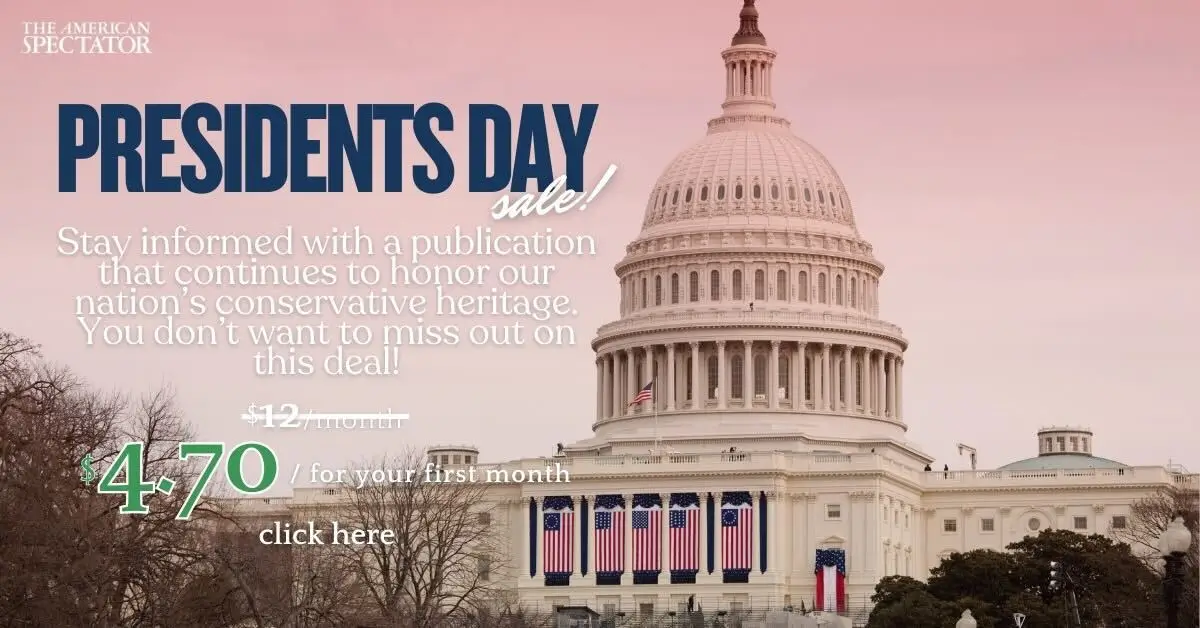The twenty-first century will be known as the Indo-Pacific century. It is already the scene of the most intense great power competition since the Cold War. China and the United States are battling for global preeminence, with the Indo-Pacific as the immediate theater of conflict. Open kinetic war is not inevitable. China would like to achieve global preeminence without fighting, as Sun Tzu counseled. The U.S. wants to maintain its global preeminence, also without fighting. Both sides likely recognize that war will benefit neither of them because in war things always go wrong. But that doesn’t mean that war is out of the question. Geopolitical competition can always drift into open conflict if leaders are not careful and flexible. It is best to be prepared. As George Washington said: “To be prepared for war is one of the most effectual means of preserving peace.”
Subscribe to The American Spectator to receive our spring 2025 print magazine, which includes this article and others like it.
Both the U.S. and China are making moves on the global chessboard, and President Donald Trump recognizes that moves to shore up our capability to defend the Americas will help to improve our ability to effectuate our Indo-Pacific strategy. Trump talks about acquiring Greenland and the Panama Canal, in what some observers characterize as a “return” or the “rebirth” of the Monroe Doctrine. President Xi Jinping continues to seek “reunification” with Taiwan and to expand the geographical reach of the Belt and Road Initiative. Both great powers are using economic leverage to improve their geopolitical positions. China benefits from geography in the Indo-Pacific, just as we benefit from geography in the Western Hemisphere. The United States maintains its presence in the Indo-Pacific by alliances and sea and air power. China has built the world’s largest navy and is rapidly expanding its nuclear arsenal. The United States benefits from its alliances with Japan, South Korea, and the Philippines, and its improving relations with India and Vietnam.
China is increasingly challenging the Monroe Doctrine by improving diplomatic and economic relations with Central and South American countries. It is also growing closer to Russia, Iran, and North Korea, and looking to improve its position in the evolving scramble for minerals and trade in the Arctic Ocean. Chinese leaders are motivated by ideology (Marxism-Leninism-Maoism) and history (the Middle Kingdom, Tianxia, the century of humiliation). U.S. motivations alternate between Wilsonian idealism and geopolitical realism. Trump is a geopolitical realist.

American foreign policy has promised a “pivot” to Asia since the Obama years, but, aside from the last two years of Trump’s first term, the pivot was more rhetoric than reality. Trump will likely accelerate the pivot he started in 2018. His national security team is made up mostly of China hawks led by Michael Walz, Pete Hegseth, Marco Rubio, John Ratcliffe, Peter Navarro, and Elbridge Colby.
Trump will likely shift resources from Europe (NATO) and the Middle East to the Indo-Pacific. Resolving the wars in Ukraine and Gaza will facilitate that shift, which is one motivation for doing so. Trump will likely avoid peripheral wars the way Ronald Reagan did in the 1980s in order to focus on the “main enemy” (China) and what Clausewitz called the “center of gravity” (the Indo-Pacific).
Trump tried to reach out to Russia early in his first term, recognizing that better relations with the leaders in the Kremlin would improve our relative power position vis-à-vis China, but domestic politics (the Russia hoax) interfered with that effort. Expect Trump to revive that effort, especially if he can mediate an end to the Ukraine war. While “triangular diplomacy” Nixon-Kissinger style may not yet be possible, even slightly weakening the Sino-Russian “strategic partnership” makes geopolitical sense.
There is a “strategic logic” for the United States to acquire the Panama Canal and Greenland.
Trump has signaled that he plans to reinvigorate U.S. enforcement of the Monroe Doctrine. Control of the Panama Canal, or at the very least lessening China’s influence there, is a first step. Efforts to improve relations with our Western Hemisphere neighbors will likely follow. Acquiring Greenland or at least acquiring more military bases on Greenland (we have a space force base there that was renamed to Pituffik Space Base as part of the Biden Pentagon’s DEI program) is another step.
The respected naval strategist James Holmes has already written about what he calls the “Trump Corollary to the Monroe Doctrine.” Holmes writes that there is a “strategic logic” for the United States to acquire the Panama Canal and Greenland. “Greenland fronts on the Arctic, an emerging theater of strategic competition,” Holmes explains, “while abutting the Greenland-Iceland-U.K. gap, Russia’s access to the North Atlantic.” Greenland and the Arctic have plenty of critical minerals, Holmes continues, and “China has been nosing around for mining rights along with its other activities as a self-proclaimed ‘near-Arctic state.’” And if China were to shut the Panama Canal in times of war, it would make it more difficult for the United States to send warships and material to the Indo-Pacific theater. “Control of the two sites,” Holmes writes, “would bolster strategic defense of the Americas,” which is what the Monroe Doctrine is all about.
Although named after the president who announced it in a message to Congress on December 2, 1823, the Monroe Doctrine was the brainchild of Secretary of State John Quincy Adams. The Monroe Doctrine resulted from Adams’ concern that the European Holy Alliance would attempt by force and/or diplomacy to restore Spain’s and Portugal’s former colonies in the Americas to the Spanish and Portuguese crowns. In July 1823, Adams, with Monroe’s approval, summoned Russian minister Baron von Tuyll to the State Department, where he told him that the “American continents are no longer subjects for any new European colonial establishments.” Mindful of the inadequacies of the U.S. Navy, Adams consulted with British officials whose interests coincided with America’s on this issue. Monroe reached out to Thomas Jefferson and James Madison, who concurred that it was essential to get Great Britain on our side to help enforce such a policy.
Adams prepared a draft on the foreign policy portion of the president’s annual message to Congress. It was subsequently discussed at a Cabinet meeting, where Adams stated that the president would in a “moderate and conciliatory manner but with a firm and determined spirit … declare our expectation and hope that the European powers will … abstain from the attempt to spread their principles in the American hemisphere or to subject by force any part of these continents to their will.” As Adams biographer Randall Woods notes, “Here was the heart of what would become known as the Monroe Doctrine.”
Thereafter, the Monroe Doctrine evolved into a core principle of American foreign policy as presidents from James Polk to Andrew Johnson to Theodore Roosevelt to Franklin Roosevelt to John Kennedy to Ronald Reagan periodically invoked the Monroe Doctrine to support U.S. diplomatic and military actions. Yet the Obama administration declared in 2013 that the Monroe Doctrine was “dead,” which was an invitation to outside powers like China to gain footholds in the Western Hemisphere, and a signal to countries in the Western Hemisphere that they would suffer no backlash for doing business with America’s enemies.
The roots of Obama’s abandonment of the Monroe Doctrine can be found in the widely accepted idea that China’s economic reforms under Deng Xiaoping would translate into political reforms that would enable China to join the so-called “rules-based international order.” This was a bipartisan error that led to China’s growing economic influence in Latin America. But China’s inroads in Latin America increased dramatically with the Belt and Road Initiative, which began in 2013, the very year that Obama’s secretary of state, John Kerry, announced the end of the Monroe Doctrine. President Xi Jinping has visited the region five times since 2013, and eight Latin American presidents visited China in 2023. China has entered into “comprehensive strategic partnerships” with Venezuela, Brazil, Argentina, Chile, Mexico, Peru, and Ecuador.
But it is China’s growing influence in Panama that poses the greatest national security threat to the United States in Latin America. Panama was the first Latin American country to join China’s Belt and Road Initiative. U.S. Southern Command has warned that China’s construction of ports on both sides of the Panama Canal will enable China to readily shift its use from civilian to military purposes. In a recent article, John Yoo and Robert Delahunty write that “[e]ffective Chinese control of the Canal, even in peacetime, would be seriously detrimental to the US defense posture and threatening to our economy.” In wartime, it would inhibit our navy’s ability to move ships between the Atlantic and Pacific Oceans. And anything that inhibits the movement of our warships through the canal would negatively affect our ability to achieve victory in a conflict with China in the Indo-Pacific.
Greenland, which is an autonomous territory of Denmark, is situated in the northern part of the Western Hemisphere. It is geographically an island extension of the North American continent. America’s interest in Greenland dates back at least to 1868 when Secretary of State William Seward, after successfully purchasing Alaska from Russia, shifted his focus to Greenland. During World War II, after Germany took control of Denmark, the United States secured military base rights on the island and gained access to weather stations and important minerals for the war effort. During the Cold War, U.S. officials viewed Greenland as a strategic post for denying Soviet warships access to the Americas. This naval chokepoint was known as the Greenland–Iceland–U.K. gap.
In the twenty-first century, Greenland’s importance to U.S. security has increased as the Arctic Ocean warms, creating a new, if limited, maritime highway (the famed Northwest Passage) and enabling access to natural resources. The Arctic has vast oil and natural gas deposits. Russia’s lengthy Arctic coast and its growing fleet of icebreakers give it an edge in the Arctic geopolitical competition. In 2018, China declared itself a “near Arctic” power that intended to forge a “Polar Silk Road” as part of the Belt and Road Initiative. A recent RAND study noted that in the Arctic, Russia and China “are operating in increasingly close proximity to North America.” And the Sino-Russian Arctic partnership encompasses both economic and military cooperation. The RAND study suggests that this is an area where the United States can exploit potential rifts between China and Russia.
James Holmes is not the only naval strategist who thinks Greenland is important to U.S. national security. Former NATO Supreme Commander retired Admiral James Stavridis, no fan of Donald Trump, recently said that Greenland is a “strategic goldmine for the United States.” Stavridis noted that Greenland “sits at the very top of the North Atlantic. It protects approaches to our own country … It’s geographically very important. It’s full of strategic minerals, rare earth, probably a lot of gold.”
In the end, the Trump Corollary to the Monroe Doctrine is about securing the Western Hemisphere from potential adversaries, especially China. Just over two hundred years ago, President James Monroe and Secretary of State John Quincy Adams proposed to erect a geopolitical fence around the Western Hemisphere, and it was that geopolitical fence (once we acquired sufficient naval power to support it) that enabled the United States to intervene in two World Wars and to wage a successful Cold War in the twentieth century. China’s challenge in the Indo-Pacific comes at a time when Adams’ fence is rotting away due to bad decisions (the Carter administration’s ceding of the Panama Canal to Panama), wishful thinking (that China would become a stakeholder in the rules-based international order), and the public abandonment of the Monroe Doctrine by the Obama administration. Trump’s proposed reinvigoration of the Monroe Doctrine is, in the words of two legal/national security experts, “returning to one of the great principles of American foreign policy.”
Subscribe to The American Spectator to receive our spring 2025 print magazine.























